By Rick Kattelmann
All the fanfare surrounding the introduction of the Sony NEX-7 caught the attention of many photographers interested in a small camera capable of high-quality results, myself included. I duly entered the pre-order lottery back in August and got lucky with a package arriving just before Christmas. I had read plenty of reviews and commentary before the camera arrived, including those published here.
So, I felt reasonably familiar with the camera before unpacking the box and could get right to the big question: how would image quality compare to the Sony A900, my primary tool of recent years?
My immediate goal was to learn whether the NEX-7 could supplement, substitute for, or even replace the A900. There have been several reviews of the Sony A900 published here in the past.
Sony A900 Field Report, by Nick Rains
Sony A900 One Year Later, by Bill Caulfeild Browne
I had been fortunate to find a Canadian A900 when they were first released at an absurdly low price before Sony tightened up the international pricing structure. The camera has proven to be superb for my particular uses (landscape, nature, travel, and miscellaneous opportunities as they appear). The only 35 mm SLRs that I had used were Minoltas, so the residual Minolta DNA in the A900 was welcome in the ergonomics as well as in the colors produced through the old Minolta lenses. The A900 works great in the cold, has been bounced around in a backpack for several weeks in the Sierra Nevada, has been well used in Asia, and has weaned me away from big film. Its only real drawbacks are size and weight, which I had not considered as drawbacks until the NEX-7 appeared.
Until now, I would not have imagined that a little camera (NEX-7) could produce prints (which are my usual end product) of similar quality to those generated from a big DSLR (A900). Four years ago, I would not have imagined that a big DSLR was about to convince me to leave the trusty Mamiya 7 and Walker 4×5 at home most of the time. In that case, I never did any comparative testing. I merely began to notice that the prints based on files from the A900 were usually just as good (though with a different “look”) as prints from scans of the medium- and large-format film. And, of course, the A900 was a lot more convenient to use. The NEX-7 will obviously be a lot more convenient to carry.
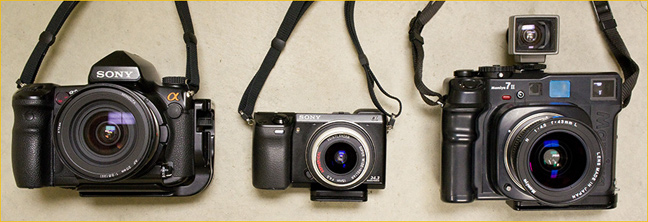
A900 NEX-7 Mamiya 7
Size of the NEX-7 relative to its predecessors in my kit.
The NEX-7 shares some design elements with the venerable Mamiya 7ii.
So, can the NEX-7 deliver the goods? Can that little APS-C sensor produce output on par with output from the bigger sensor of the A900? Can the NEX-7’s reduced frame size significantly benefit from using only the central portion of lenses designed for “full-frame” coverage?
Being impatient to learn about the potential of the little camera relative to its bigger older cousin, some comparisons were clearly in order. However, I have yet to learn of an ideal means of directly comparing two markedly different cameras. Comparison is relatively easy when the sensors are the same size and the lens mount is the same; though, comparisons between the A900 and A850 aren’t very exciting.
As Michael Reichmann noted in his “Rolling Review” of the NEX-7, comparisons are “fraught with peril” and will not satisfy much of the internet audience. Nevertheless, there seems to be ample interest among readers of the Luminous Landscape in both the gracefully aging A900 and the upstart NEX-7. I needed to satisfy my own curiosity about whether the big camera could be left behind while skiing, hiking, or traveling abroad. Having done this particular comparison exercise, I’m glad to share it with anyone considering the same basic questions I had.
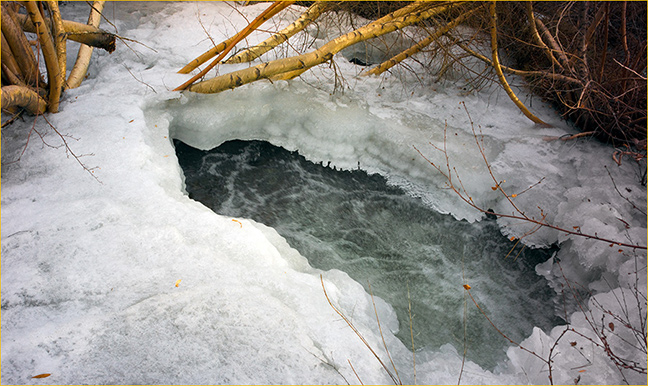
Winter Opening
The deep dark hole of camera comparisons. December, 2011
NEX-7 with 15 mm Voigtlander Heliar @ ISO 400
A Personal Approach to Gear Testing
When an intriguing new (to me) piece of gear appears, I generally perform some simple-minded testing to make sure the thing works and does basically I what I hoped it would do when the purchase decision was made. I’ve experimented with a lot of older well-used lenses, including several copies of a particular model, when necessary. A basic routine has developed in which test pictures are taken of a few shelves of books, a wall or two inside our house or garage, and then a few scenes around the backyard depending on the nature of the lens. This rut into which I’ve fallen at least provides some consistency over time, so I have a fairly good mental image of what a reasonably “sharp” and “good” photographic image of each scene should look like.
Bottom line for this comparison: I was interested in whether the NEX-7 could produce respectable prints up to 12×18 or 15×20 inches of subjects with fine detail that were similar to those I’ve made with the A900, under my typical working conditions: tripod mounted, remote release, subject distance of 10-50 feet, aperture of f/8 to f/11, and ISO of 200-400.
Although I’ve seen remarkably good large prints allegedly produced from cell-phone images, landscapes with fine detail usually benefit from more pixels and less up-rezzing. My personal experience has been that printing at sizes up to the ol’ rule-of-thumb of image dimensions (# of pixels) divided by 300 (pixels per inch) [e.g., 13×20 inches from the 4000×6000 pixel file of the NEX-7] yields prints of consistently “decent” quality. Defining what constitutes a decent print (regardless of subject matter) is way beyond the scope of this article and probably beyond my capability. So, I’ll just say that the colors and tones should be believable and the detail that is obviously intended to be distinct should not be fuzzy or blurred — in other words, I know it when I see it.
Although I shoot plenty of pictures handheld, my best prints have almost always come out of a tripod-mounted camera (plus remote release, mirror up [where appropriate], adequate time for everything to settle down, no wind, no earthquakes, etc.).
My typical working distance for pieces of the landscape tends to fall between 10 and 50 feet. With shorter focal lengths, an aperture between f/8 and f/11 tends to render most parts of the scene adequately sharp. For my tastes in subject matter, one of the appealing aspects of the smaller sensor size is the associated shorter focal-length lenses and generally greater depth of field (all else being equal, blah-blah-blah).
The sensor of the Sony A900 seems to have optimum output at an ISO of 320 as discussed within the forum pages of the Luminous-Landscape. I’ve bought into that notion and, well, works for me. So, I’ve gotten into the habit of using ISO 320 almost all the time, except for ISO 100 for high-key subject matter, where there may be slightly better tonal separation. I haven’t had the need for higher sensitivities and have ignored the recent pre-occupation with high-speeds and noise characteristics. I was perfectly happy with Kodachrome 25, rating Fuji Velvia at 40, and using a Kodak 14n at ISO 6.
Details of Procedures for this Comparison
I wished to keep things simple as well as avoid the whole resizing can-of-worms in this comparison and just used an operational (photographing rather than testing) approach: to capture roughly the same scene with the NEX-7, either use a shorter lens than one would with the A900 or use the same lens and move back. In actual practice, I would use a shorter lens. So, most of the testing followed that path.
Seven pairs of lenses that had roughly equivalent fields of view on the respective cameras were compared. Each camera was secured to the tripod, and the shutter was released with a remote (after waiting at least 10 seconds following mirror lock-up in the case of the A900). Image stabilization was off for the A900 (the NEX-7 lacks in-body stabilization and none of the lenses tested offered stabilization). The tripod (an old wood Zone VI) and Acratech ball head were not moved during the camera swap. An ISO of 400 and an aperture of f/8 was used on both cameras. All test images were recorded as raw files; jpegs from the NEX-7 with the initial firmware were not usable for comparison purposes.
The tests reported here involved shooting the same scenes with lenses of roughly equivalent fields of view: 15 mm (on NEX-7) vs. 20 mm (on A900), 25 vs. 35, 28 vs. 45, 35 vs. 50, 90 vs. 135, 135 vs. 200, and 200 vs. 280 (1.4x extender on 200). In an attempt to reduce the number of variables (of which there are obviously many), I also used the same lens on both cameras and moved the camera to adjust the field of view and tried a couple of zoom lenses on both cameras. In this latter set of tests, three alpha-mount zoom lenses (17-35, 28-135, and 70-400 [via the LAEA-1 adapter on the NEX-7]) set for equivalent fields of view on the two cameras were used. I realize the optical properties of zoom lenses change with focal length but probably less so than with two independent lenses. None of these three heavy zooms is likely to be matched with the NEX-7 in daily practice, but they offered a different aspect to the comparisons. Although the NEX-7 looks a bit silly on the 70-400 mm zoom, in some cases, it produced sharper images with this lens than did the A900.
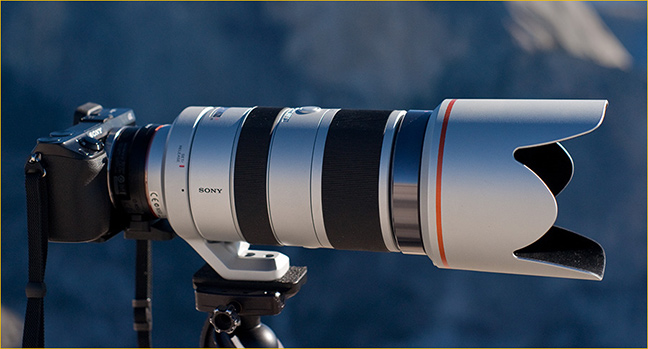
NEX-7 70-400mm
Overkill? A mismatch of size — big lens on little camera.

Clouds Rest
The awkward combo can be useful for pulling details out of the big landscape.
Clouds Rest from North Dome, Yosemite National Park.
NEX-7 with Sony 70-400 mm, New Years Day, 2012
With respect to processing, NEX-7 raw files were converted to .dng files and then processed with Adobe Camera Raw. The DNG conversion may become part of my standard “workslow” because of the need to use Cornerfix on files from some wide-angle lenses. After some amount of on-screen pixel-peeping to satisfy my curiosity, samples of the test pictures were selected, crops were made of corner portions, and prints were made on a HP Z3100. I recorded my impressions from both the monitor observations and prints on a subjective scale ofgreattoyuck. The results are summarized in the table below and the explanatory text that follows. Although comparative images displayed on the web can (and will) be criticized for a variety of reasons, samples are presented below because they are expected in comparisons like this one and might just illustrate a few points. While fiddling around with various images during this comparison, I noticed how my impressions were affected by relatively subtle differences in image processing. I’m now further convinced that with comparisons such as these, if a difference doesn’t really jump out to you, don’t worry about it for practical purposes.
Observations and Impressions
In almost all cases involving the fixed lenses, the central third to two-thirds of the image looks great. When it didn’t, there was probably a blunder in the procedure, either poor focus or camera movement. Therefore, most of my remarks refer to the corners — that’s where the obvious differences popped out.
A900
NEX-7
EQUAL
15mm f/4.5 Voigtlander Heliar
EQUAL
25mm f/4 Voigtlander Color-Skopar
BETTER THAN
35mm f/2 Minolta Maxxum
40mm f/2 Minolta M-Rokkor
EQUAL
85mm f/2 Minolta MD Rokkor
BETTER THAN
135mm f/2.8 Minolta Maxxum
EQUAL
200mm f/2.8 Minolta Maxxum
With very good lenses on both cameras, the results were a draw. In the two cases where the A900 showed better results, the lenses used on the A900 are just better than those chosen for the NEX-7. The good ol’ 50mm was the standout performer; it worked great on the NEX-7 as well, but I don’t have anything in the neighborhood of 75 mm for the A900 for comparison purposes. The Minolta lenses produced images with considerably warmer color balance and generally more pleasing colors.
A sample of 100 % crops (unsharpened) from three pairs of lenses…
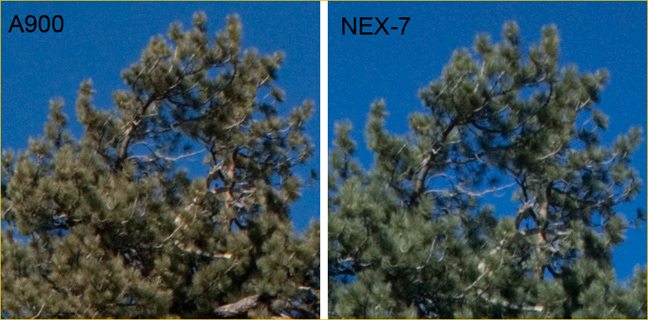
For very wide angle lenses, the 20 mm Minolta Maxxum on the A900 and the 15 mm Voigtlander Heliar produced respectable results.
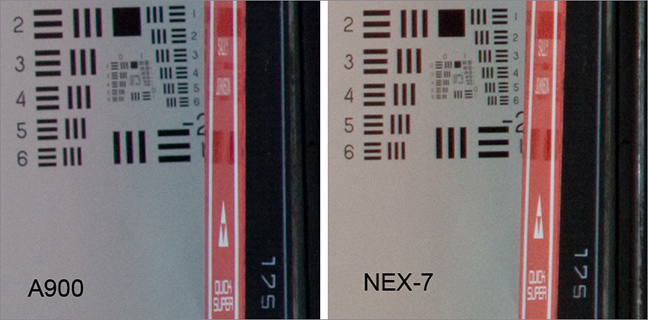
An old resolution chart behind our ski rack was one of the indoor subjects.
A 135 mm Minolta Maxxum lens on the A900 vs. an 85 mm Minolta MD lens on the NEX-7.
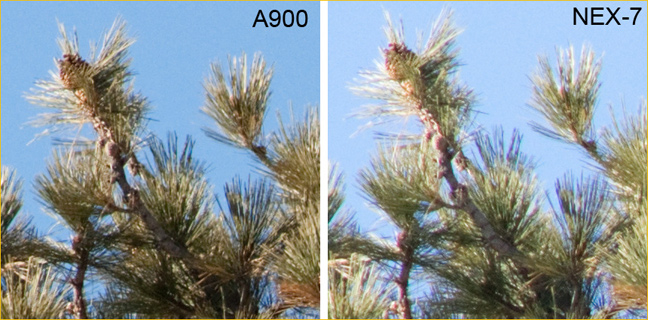
Pine needles at about 150 feet were photographed with Minolta Maxxum lenses: 200 mm on the A900 and 135 mm on the NEX-7.
The first comparison of the two cameras where the 70-400 mm zoom was used at different focal lengths to yield equivalent fields of view for the respective cameras was indoors of a couple of shelves of books about 12 feet from the lens. Here, the initial results were inconclusive. Only a couple of the images from either of the cameras were adequately sharp. A few days later, the tests were repeated using flash to minimize possible impacts of slow shutter speed and camera shake. That changed everything: all images were adequately sharp. Both cameras took good advantage of this fine lens at close working distances. The experience also taught me to use flash for interior testing when vibrations could be a confounding factor. At greater distances (infinity, 200 feet, and 150 feet), the results from the NEX-7 were usually sharper than those from the A900.
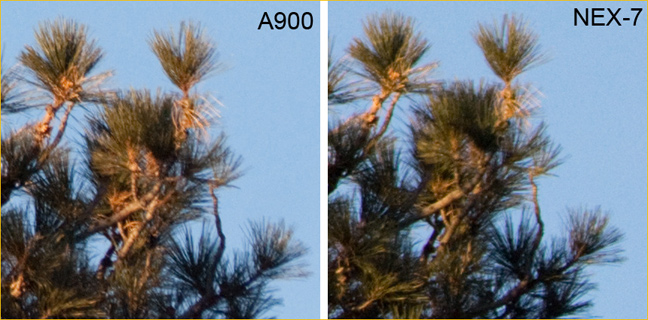
With the 70-400 mm lens, the two cameras were about evenly matched at 150 mm on the A900 and 100 mm on the NEX-7, depending where one looks.
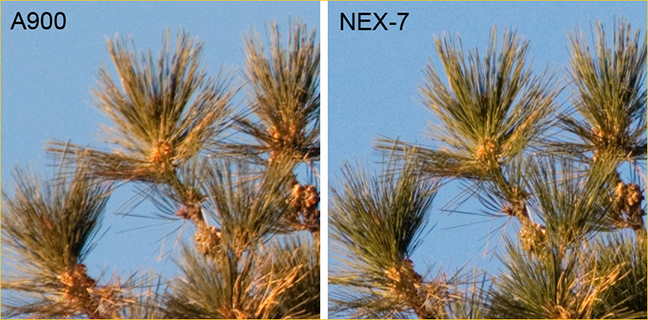
Set at 300 mm on the A900 and 200 mm on the NEX-7, the 70-400 zoom shows the usual results of being a tad sharper on the NEX-7.
The following hypotheses might explain the generally better results from the 70-400 on the NEX-7: (1) I had better try again on the micro-adjustment for the A900 at distances approaching infinity; (2) the Live View and peaking capabilities for focusing with the NEX-7 are superior to the auto-focus of the A900; (3) the lens shakes less with the little camera than the big camera (even after waiting 10-20 seconds following mirror lock-up); (4) the NEX-7’s APS-C size sensor is taking advantage of the central portion of the image produced by the lens.
The 17-35 mm Minolta Maxxum zoom was used at 24 mm on the A900 and 17 mm on the NEX-7 and again at 35 and 24, respectively. In both pairs, the results from the A900 were surprisingly good (might even call them excellent) and those from the NEX-7 less so.
With the 28-135 mm Minolta Maxxum zoom (a particularly fine quality mid-range zoom that I’ve used when changing lenses just wasn’t a good idea), the results from the NEX-7 were clearly better than those from the A900 across the range of focal lengths. Although the centers of both sets of images were quite sharp, the edges of the full-frame images were not. The smaller sensor was a real advantage in this case.
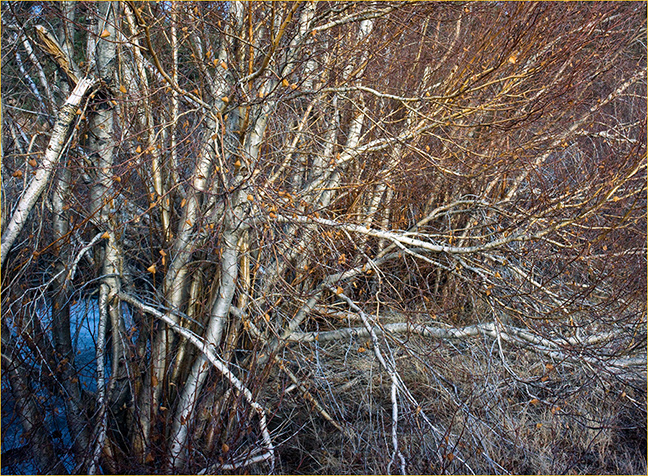
Water Birch, Rock Creek, eastern Sierra Nevada, California.
NEX-7 with 15 mm Voigtlander Heliar @ ISO 800
Conclusions
The NEX-7 certainly seems up to the task, at least for my intended uses. I look forward to the weight and bulk savings on future backpack trips. For now, the A900 will still find a lot of use, mainly because I have become so accustomed to how it works. After getting accustomed to Live View (particularly for precise focusing) on the NEX models, it is the one new-fangled feature that I find lacking on the A900. Checking focus on the NEX-7 is simply far more effective than on the A900. As this year progresses, both cameras will get used in many different situations, and many prints will be made. Subconsciously, one will gradually get chosen more than the other. At the end of 2012, I’ll be curious to see which one.
January, 2012
Rick Kattelmann
Rick Kattelmann is a semi-retired hydrologist who used photography to document research and water projects in mountain areas around the world. He has been an active amateur photographer for 45 years and has lived in the Sierra Nevada of California for the past 30 years. In retirement, he is finally trying to make more use of his image archives and getting around to exhibiting and sharing photographs. A small sample of his photos from Asia can be found atwww.kattelmann.com.
You May Also Enjoy...
Workshop – Getting The Most From Your Digital Files
Sorry – This Series Has Been Cancelled Most photographers learn a few basic techniques in Photoshop and let it go at that. But there's a
Joshua Tree 2
A Graphical Look In January, 2000 I returned to shoot at Joshua Tree for the fifth time. Every visit has produced somewhat different images. This
